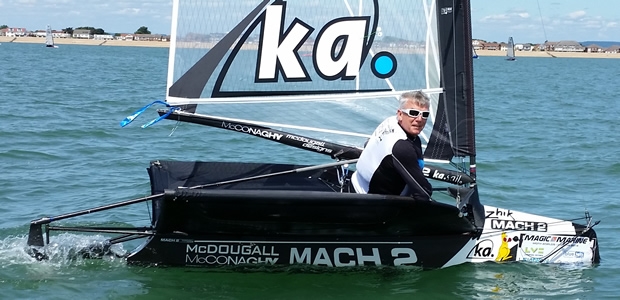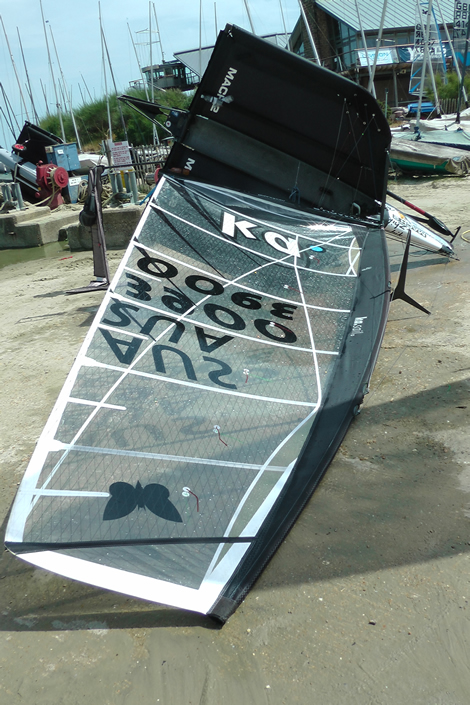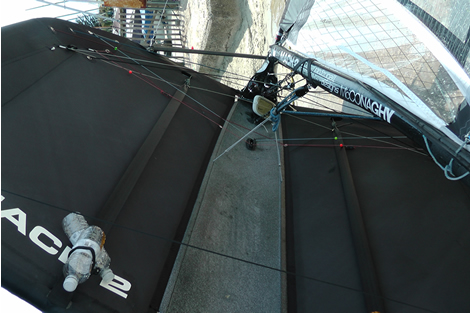
The secrets of AMac
Moth guru Andrew McDougall is Europe at present, having first attended the Italian Moth Nationals and Foiling Week on Lake Garda and this week has been sailing the Moth Worlds at Hayling Island Sailing Club.
At Foiling Week McDougall was addressing the wider issue of foiling generally…Since what were felt at the time to be the seemingly impossible photos of Rohan Veal foiling (now more than a decade ago), the Moth has become the first popular and commercially successful foiler, following on from Hobie’s attempts with their Trifoiler, the production version of Russell Long’s.
But oddly, for the most part this has failed to be scaled up in the monohull world. McDougall gives his thoughts on the reasons for this: “Really it is like why you buy a bicycle and not a tricycle: It just works at that size on a small boat, because you can carve it, and you don’t get thrown off when you go around a corner like you would on a tricycle. It is quite natural to sail, whereas I have sailed Brett Burville’s boat, where I got completely ejected when I tried to turn it. As you turn it goes this way and accelerates and suddenly you are just gone!”
Brett Burville’s Moth had more of a trimaran-style set-up with lifting foils mounted beneath the wingbars.
McDougall continues: “It is exactly the same mechanics with a bike. Scale it up and it is why most people drive cars - it is more practical, easier, etc. The Moth is the perfect size for the bi-foiler. I don’t think realistically it works as you have more people on it.” This is why more larger foilers have been catamarans, he maintains. He also likes the simplicity of the Moth and its ‘bi-foiler’ format, how you can sail heeled to windward to offset the centrifugal forces, how it is easy to manoeuvre, etc.
However he qualifies his view. At the time Rohan Veal began foiling, McDougall was his coach and admits he told Veal off for going off on a tangent. “So I was as guilty as anyone in thinking it wasn’t do-able. So when I say ‘I don’t think the bi-foiler makes sense to scale up’, that’s what I believe right now, but I am probably going to be proven wrong. But on the Moth when we hit the stay at 30 knots, the boat moves because it only weighs one third of your weight. You hit the stay at 30 knots on an 18ft skiff, you move and things get really nasty…”
Currently McDougall remains deeply involved with the Moth class as designer of its two most prolific foiling boats – the Bladerider and the Mach 2. To give some indication of the scale – to date McConaghy China has built around 455 Mach 2s alone and with those they have on order, the number is now approaching 500.
So when will the Mach 3 come out? “I am not planning on bringing out a full new boat,” says McDougall. “There are things I can sort of see, we might be able to make it easier to tack for example, but the Mach 2 platform is actually pretty good. I spent a lot of time on that hull, just trying to work out the ergonomics of it. A lot of the guys are shortening the wing bar further forward, but the way I sail you need every bit of it. It is a great platform and its construction is really strong. I kept building slightly lighter boats and saying ‘we’ll take some carbon out of here and see what happens and maybe I’ll put a bit more in there because we’ve seen it break there’. My boat now is two and a half years old and it has broken in four places and is just about back to standard hull weight.”
A Mach 2 hull weighs just 10.5kg and has an all-up weight of around 31.
As to the latest developments, inevitably as the technology becomes more and more refined, it is getting closer and closer in the Moth class. As McDougall puts it: “I used to have sometimes a 10% boat speed advantage, but it is now about 1%, which is not enough to make up for even one bad tack.”
In recent years, the Moth class has experienced an upscaling of the arms race. Whereas once upon a time, Moth sailors typically pitched up at events with one T-foil rudder and one main lifting foil, now top sailors come with a rudder and a spare and perhaps three main foils, some tailored to different wind strengths. For these Worlds this has been partly brought on by the light conditions (rightly) anticipated for the event.
While in the past Moth sailors have been able to change foils on the water, for the present World Championship this has been prohibited, but sailors are still changing them day to day. McDougall believes that the class should go a step further. “They really need to look at restricting it to one foil, not just to make it cheaper, but it will force us all to go down a line where the foils are practical, so you can’t go extreme with a foil that only works in 4-12 knots. Many of the UK guys in particular have specialist foils. You see them out with the wrong foil on the wrong day and they are dog slow. I have been trying to resist going too extreme, so all of our foils are in the middle.”
Saying this, for the Worlds McDougall has been sailing at these Worlds with a longer foil. As he admits: “It is pretty extreme, but I just felt like going extreme for once. Around a race course at a normal event location, a large foil is unlikely to win a series. The problem we have in Hayling is that we are quite likely to get days when it is six knots through an entire day so you can take out a bigger foil and know that you are not going to get caught out. Try that in any event in Australia and you will get caught out because suddenly it will get to race two and it is blowing 15 knots and you are slow.”
As to how they should limit it, he explains: “The way we outlawed foils off the wing bars was to say that the foils are a lifting component so let’s look at them as the hulls, so you have to not be able to see air through them. You are not allowed to change the hull so we could easily reinterprete the rule, making the foils an extension of the hull, so one set of foils for an event. I think that would help the class enormously.
“Otherwise it gets annoying and stressful, because you have to choose. It is so nice to rig your boat up, go to lunch and go sailing. Whereas at present you are thinking constantly ‘what foils should I use???’ My boat is set up so that I can adjust it and that is why I have so many strings. The boat could be rigged at 5am and nothing changes. I go out and if it is a bit windy I can adjust it on the water. I think that is a great way of going sailing.”
The strings McDougall refers to are the controls between the wand at the front of the boat and the trim tab on the trailing edge of the horizontal component of the main lifting foil. These adjust:
a) Ride height– the length of rod in between the wand and the flap, providing more or less flap movement relative to wand movement
b) The length of the wand: “In very big waves you get the wand to flick forward so it will bring the boat down vigorously if you have high gearing, so you can deal with big waves. If the wand is too long, you come up a wave and it is just too short a time for things to react and the boat just keeps going and you come out of the wave. So in waves my wand is almost a 1ft shorter than it would be in flat water.
c) Gearing, how much wand movement affects flap movement: “That is the rate of change of the ride height adjustment. Here (Garda) I would have a slightly higher gearing upwind to downwind, which is the opposite of what we used to do, because downwind you tend to have a shorter wand so it is flicking around a lot, so you don’t want it to be bouncing the boat. That keeps you safe if you get wash from another boat or a ferry, as you are hugging the water more. You pull the boat up by lengthening the control rod with the ride height adjuster and shorten the wand, so the boat is really locked to a certain height, but it be bouncing a little bit, so you reduce the gearing to stop the bounciness.”
d) The ‘elastic’ – this is attached to the top of the wand at deck level, pulling the bottom of the wand forwards. “There is the amount of tension in that – that is one of the most important adjustments on the boat because you can have everything set up and when you see some waves coming from a wash, you pull a little more of that on and it increases the rate or the amount the wand goes forward so you can get it to be more aggressively pulling the boat down. A lot of people don’t even adjust that, but to me that is really important.”
Aside from being the Moth class’ uber boat designer, McDougall also runs KA Sails, the dominant sail supplier to the class, despite strong inroads from North (who made Bora Gulari’s 2013 Worlds-winning sail). The new sail is the 16.3: “I think we had a bit of a problem with the top of the 16.1 stalling out a bit,” admits McDougall, “so we weren’t as quick as we could have been downwind. Even though the 16.3 looks the same, it got development after looking at what other people were doing. North has come in pretty hard and they definitely had a bit of a leg on us downwind while our sail was working upwind. The 16.3 is a huge leap upwind and quite big leap downwind, so you see Josh (McKnight) – he’s ballistic upwind and downwind in fact too.”
A development Bora Gulari was keen on prior to the last Worlds was enthusiastic use of a 3D printer. McDougall says he hasn’t gone down this route although they have done plenty of work minimising aero drag on the Mach 2. “There is a fair bit on the boat that wasn’t there last year. We have got new front wing bars like Simon Hiscocks has done – they are part of the package now. We have also done a whole near rear fairing which tied in everything at the back, but we just ran out of time to bring it here. And we have played with aero off the back of the boom putting an end plate on the boom itself.”
As to where this is all leading, McDougall says doesn’t have too much trouble imagining this. “The way I view it is – look in the water and look in the sky and what do you see? You see these amazing creatures that are just so far advanced from what we are. From that you get a picture of what you think a sail should be like, so you can always see way beyond what we can do, but you just don’t know how to achieve that mechanically. If we are ever allowed to do it, we could make some morphing foils which would be amazing. But at the moment a lot of stuff I do is refinement - if I can just change something a bit, it becomes a bit more like I know how it could be.”
However what McDougall is really focussed on – and he’s been talking about it long enough… - is marketing a new cheaper version of the Mach 2. Already under construction at McConaghy China, this is to be called the Waszp. In theory this is supposed to be an entry level boat, but it is still likely to cost in the region of US$ 12,000.
McDougall acknowledges that this has been on the drawing board for a while. “It took me a long time to go through all the design things, in fact five times longer than the Mach 2, because there you have a very specific thing: Hard to rig, hard to launch? Who cares? It just has to go fast. With this you have so many constraints, you are trying to work to a weight, to a price, you have to be able to launch it easily and pack it up and store it easily, etc. So it is only the last month or two that we have really finalised the design work. It has been a three year process.
“One of the big things about the Moth is the cost of the foils - they are hard to replicate, to maintain, so the foils had to be aluminium, then you get rid of all the problems with the hinge and hitting things, the price of them, etc. You can also scale them, so you can have bigger foils for heavier people or for beginners so they don’t go too fast.”
The Waszp is being made of a mix of infused glass and carbon with a carbon unstayed mast and a windsurfer-style boom. McDougall says that the hull is a little more voluminous than a Mach 2 – but not by much.
However US$ 12,000… still doesn’t sound like an entry level price.













Latest Comments
Add a comment - Members log in